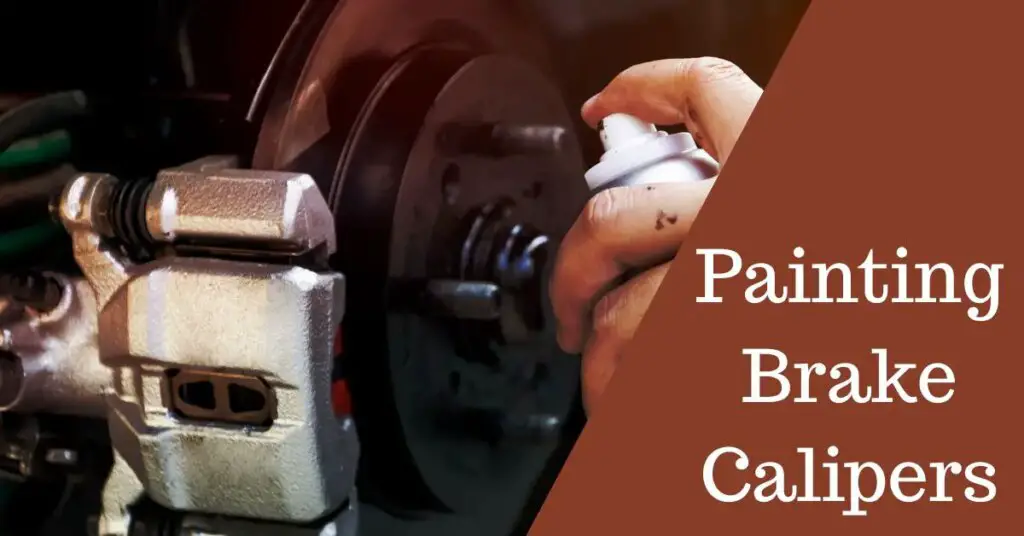When it comes to customizing your vehicle’s appearance, various options are available. One popular and affordable way to enhance your car’s aesthetic appeal is by painting the brake calipers. Not only does this modification add a touch of personalization, but it also offers practical benefits.
In this article, we will explore the process of painting brake calipers, from preparation to application, and provide valuable tips and insights along the way.
Table of Contents
Why Paint Brake Calipers?
Painting brake calipers is an excellent way to add a touch of personalization to your vehicle’s overall appearance. It allows you to showcase your style and preferences while making your car stand out. Also, painted brake calipers provide a subtle but noticeable visual enhancement that complements the wheels and adds a sporty and customized look.
Choosing the Right Paint
When choosing the right paint to paint your brake calipers, there are several factors to consider such as the type of paint suitable for high temperatures, the appropriate color and finish, heat resistance, durability, and recommended brands and products. Let’s go through each aspect in detail:
Types of Paint
Several types of paint suit this task.
High-temperature paint
Selecting a paint specifically designed for high temperatures is crucial since brake calipers can become extremely hot during braking. Look for paints that are heat resistant and can withstand temperatures above 500°F (260°C).
Enamel paint
Enamel paints are known for their durability and ability to adhere well to metal surfaces. They can provide a glossy finish and are available in a wide range of colors.
Epoxy paint
Epoxy paints are known for their excellent adhesion and durability. They can create a smooth and durable finish on brake calipers.
Color and Finish
The choice of color and finish is subjective and depends on personal preference. However, it’s important to consider the visibility of the calipers when selecting a color. Bright colors like red, yellow, or blue are popular choices as they make the calipers stand out and give a sporty look.
Regarding the finish, you can opt for either a glossy or matte finish based on your preference.
Heat Resistance and Durability
Ensure that the paint you choose has excellent heat resistance to prevent it from blistering, peeling, or discoloring due to the high temperatures generated by the brakes. Look for paints specifically formulated for automotive applications and high-temperature resistance.
Brands and Products

There are several reputable brands that offer paint suitable for painting brake calipers. Here are a few recommendations:
-
- G2 Brake Caliper Paint: G2 is a popular brand known for its high-temperature brake caliper paint kits.
- VHT Caliper Paint: VHT offers a range of high-temperature brake caliper paints that provide excellent heat resistance and durability.
- Dupli-Color Caliper Paint: Dupli-Color offers a variety of colors and finishes suitable for brake calipers, including high-temperature enamel paints.
- POR-15 Caliper Paint: POR-15 provides high-temperature epoxy paints designed for brake calipers and other automotive applications.
- Rust-Oleum Caliper Spray Paint offers heat resistance, durability, and a range of colors to customize and protect your brake calipers.
How to Paint Brake Calipers
Painted calipers can enhance the visual appeal of the vehicle, especially when using bright or contrasting colors that stand out behind the wheels. Here is a detailed guide on how to paint your brake calipers.
Tools and Materials Needed
Before you begin painting your brake calipers, gather the necessary tools and materials. Here’s a list of items you’ll need:
- Brake caliper paint
- Brake cleaner or degreaser
- Masking tape
- Plastic bags or newspaper
- Wire brush or sandpaper
- Primer
- Paint brushes or spray can
- Brake caliper decals (optional)
- Clear coat (optional)
- Gloves and safety glasses
Safety Precautions
When working on your vehicle’s brake system, it’s essential to prioritize safety. Follow these safety precautions:
- Wear gloves and safety glasses to protect your hands and eyes from chemicals and debris.
- Work in a well-ventilated area to avoid inhaling harmful fumes.
- Use jack stands or wheel chocks to secure the vehicle and prevent it from rolling.
- Take necessary precautions to prevent any contact with brake fluid.
- If you’re unsure or uncomfortable performing the painting process yourself, consult a professional mechanic or body shop.
Step-by-Step Guide: Painting Brake Calipers
Step 1: Preparing the brake calipers
Proper preparation is essential to achieve a professional-looking finish. Start by removing the wheels to access the brake calipers.
Then, use masking tape or painter’s tape to protect surrounding areas like the brake rotor, brake lines, and other nearby components. This will prevent accidental paint overspray and ensure a clean finish.
Sanding the calipers is necessary for better adhesion. Lightly sand the surface of the calipers using fine-grit sandpaper. This helps to remove any existing paint, rust, or debris and creates a rough surface that promotes better paint adhesion. Make sure to sand evenly and smooth out any rough areas.
Thoroughly clean the calipers using brake cleaner or a suitable degreaser as the following step.
Step 2: Cleaning and degreasing
Using a wire brush or sandpaper, carefully remove any loose paint, rust, or imperfections from the calipers. This step ensures that the new paint adheres properly and results in a smooth finish. Once cleaned, wipe down the calipers again with a clean cloth to remove any residual dust or particles.
Step 3: Masking off the surrounding area
To avoid overspray and unwanted paint on other components, it’s crucial to mask off the surrounding areas. Use masking tape to cover the brake lines, rotor, and any other nearby parts that should not be painted. Cover the remaining exposed areas with plastic bags or newspapers to protect them from accidental overspray.
Step 4: Applying primer
Before applying the actual color, it’s advisable to apply a primer coat. Primer helps the paint adhere better to the calipers and improves the finish. Follow the manufacturer’s instructions for your chosen specific primer, and apply it evenly to the calipers. Allow the primer to dry completely before proceeding to the next step.
Step 5: Painting the calipers
Now comes the exciting part—painting the calipers! Using either a paintbrush or a spray can, apply thin and even coats of the brake caliper paint to achieve a smooth and consistent finish. Apply multiple coats as needed, allowing each coat to dry before applying the next. Be patient during this process to ensure a flawless result.
Step 6: Curing and drying
Once you have applied the desired number of paint coats, allow the calipers to cure and dry according to the paint manufacturer’s instructions. This step is crucial for the paint to bond and harden, ensuring its durability and longevity fully. Avoid driving or exposing the calipers to moisture until they are fully dry.
Step 7: Reinstalling the calipers
After fully-curing paint, carefully remove the masking tape and plastic bags/newspaper. Reinstall the brake calipers, ensuring all bolts and hardware are tightened correctly. Double-check the brake lines for any signs of damage or leaks before placing the wheels back on the vehicle.
Check out this video for more detail!
Common Mistakes to Avoid when Painting Brake Calipers Yourself
When painting brake calipers yourself, there are several common mistakes to avoid to ensure a successful and safe outcome. Here are some key points to keep in mind:
- Inadequate preparation: Failing to prepare the calipers properly is a common mistake. Make sure to clean them thoroughly to remove any dirt, grime, or brake dust. Use a degreaser or brake cleaner to ensure a clean surface for paint adhesion.
- Insufficient masking: It’s crucial to mask off surrounding areas such as brake lines, rotor surfaces, and other components to prevent overspray and damage. Neglecting proper masking can result in unwanted paint on crucial parts, potentially leading to braking issues.
- Using improper paint: Choosing the wrong type of paint can cause problems. It’s essential to use high-temperature brake caliper paint specifically designed for automotive applications. Regular spray paint or low-quality paint may not withstand the heat generated by the brakes, leading to peeling, fading, or even flaking.
- Skipping primer: Applying a primer coat is essential for promoting paint adhesion and enhancing the longevity of the finish. Make sure to select a primer suitable for high-temperature applications and follow the manufacturer’s instructions for proper application.
- Rushing the process: Taking your time during the painting process is crucial. Rushing can result in uneven coverage, drips, or runs. Follow the recommended drying times between coats and allow sufficient time for the paint to cure before using the brakes.
- Neglecting safety precautions: Safety should be a top priority when working with brake calipers. Ensure you wear appropriate personal protective equipment, including gloves and eye protection. Also, avoid getting any paint or solvents on the brake pads or rotor surfaces, as it can compromise braking performance.
- Over-tightening or misaligning caliper components: When reinstalling the calipers, avoid over-tightening the bolts, as this can damage the caliper or create a brake drag. Ensure proper alignment of the caliper to avoid uneven brake pad wear or rubbing against the rotor.
Compare Hand vs Spray Painting Brake Calipers
Now we all know how to paint brake calipers; the remaining question is about the technique. Should we hand or spray painting?
Here is a comparison of the two methods:
| Comparison Factors | Hand Painting Brake Calipers | Spray Painting Brake Calipers |
| Control and Precision | High | Moderate to High |
| Accessibility | Good | Moderate |
| Cost | Low | Moderate to High |
| Time and Effort | High | Moderate to High |
| Efficiency and Speed | Low | High |
| Uniformity | Moderate | High |
| Overspray and Masking | N/A (No overspray) | Important |
| Equipment and Setup | Minimal | Requires specialized equipment |
| Professional Appearance | Possible with skill | Consistently achievable |
Advantages of hand painting brake calipers
- Control and Precision: Hand painting allows for greater control and precision. You can carefully apply paint to specific areas with a brush or small roller, ensuring even coverage and avoiding overspray.
- Accessibility: Hand painting is advantageous when dealing with intricate or hard-to-reach areas on the calipers. The ability to maneuver a brush or roller allows for better access to tight spaces.
- Cost: Hand painting is generally a more cost-effective method. Brushes, rollers, and paint supplies are relatively inexpensive compared to spray painting equipment.
- Time and Effort: Hand painting can be time-consuming, especially if you need to disassemble and reassemble the calipers. It requires patience and attention to detail to achieve a professional-looking finish.
Advantages of spray painting brake calipers
- Efficiency and speed: Spray painting can be faster than hand painting, especially for large, flat surfaces. The spray gun covers larger areas quickly and evenly.
- Uniformity: Spray painting typically results in a more uniform finish, with a smooth and consistent layer of paint. It can provide a professional look without visible brush strokes.
- Overspray and masking: Spray painting requires proper masking and preparation to prevent overspray on surrounding areas. Adequate masking of brake lines, rotors, and other components is crucial to avoid paint contamination.
- Equipment and setup: Spray painting requires specialized equipment, including a spray gun, air compressor, and appropriate safety gear. This may involve additional cost and setup time, especially if you don’t already have the necessary equipment.
Ultimately, choosing hand painting and spray painting brake calipers depends on personal preference, available resources, and desired outcomes.
Hand painting offers more control and precision, while spray painting can provide a faster and more uniform finish.
Should I Remove the Brake Calipers for Painting?
One more issue related to this painting task is about disassembling brake calipers. Is it possible to paint brake calipers without removing them? It’s obvious that we don’t want to mess up with the brake function.
Removing the brake calipers for painting is not always necessary, but it can provide several advantages. Here are some considerations to help you decide:
- Access: Removing the brake calipers allows for better access to all sides of the calipers, making it easier to paint and ensure even coverage. It also allows you to paint smaller components separately, such as the caliper brackets or pistons.
- Masking: While you can mask off the surrounding areas, removing the calipers eliminates the need for extensive masking. This reduces the risk of overspray and potential damage to other components, such as brake lines or rotors.
- Thorough cleaning: Taking the calipers off the vehicle allows for a more thorough cleaning process. You can properly degrease and clean the calipers, ensuring a clean surface for better paint adhesion.
- Rust or corrosion treatment: If your calipers have any rust or corrosion, removing them provides an opportunity to address these issues properly. You can clean, sand, and treat the affected areas before painting, enhancing the longevity of the finish.
- Personal preference: Some individuals prefer the appearance of painted calipers when they are completely removed from the vehicle. It can provide a more professional and finished look.
However, there are a few factors to consider before deciding to remove the calipers:
- Complexity: Removing and reinstalling brake calipers can be a relatively straightforward process, but it requires basic mechanical skills and knowledge. If you’re not confident in your abilities, it may be best to seek professional assistance.
- Brake system integrity: When removing the calipers, it’s important to handle them with care and avoid damaging any brake lines or other components. Ensure you properly support the calipers to prevent strain on the brake lines.
- Time and effort: Removing the calipers adds an extra step to the painting process, which may require more time and effort. If you’re working on a tight schedule, you may choose to paint the calipers while they are still mounted.
How to paint brake calipers without removing them
As the guide above, you still need those tools and materials and clean the calipers thoroughly before painting. The steps are quite similar, except that you have to cover other parts more carefully.
Step 1: Mask off surrounding areas
Use masking tape to cover the areas you don’t want to paint, such as brake lines, rubber seals, or brake pads. Be thorough and ensure a tight seal to prevent overspray.
Step 2: Protect the rotor surface
Insert plastic bags or garbage bags behind the caliper, covering the rotor surface entirely. This prevents accidental paint overspray or drips from reaching the rotor.
Step 3: Prepare the caliper surface
Lightly sand the caliper surface using fine-grit sandpaper or a wire brush. This helps create a roughened surface for better paint adhesion. Wipe away any dust or debris with a clean cloth.
Step 4: Apply the paint
Stir the brake caliper paint thoroughly before applying. Carefully apply the paint to the caliper surface using a brush or small roller. Start with thin coats and build up as needed. Ensure even coverage and smooth strokes. Avoid excessive paint application that may lead to runs or drips.
Step 5: Allow the paint to dry
Follow the manufacturer’s instructions for drying time between coats. Typically, multiple thin coats with sufficient drying time in between are recommended. Ensure the paint is fully cured before using the brakes.
Step 6: Remove the masking
Remove the masking tape and plastic bags carefully once the paint is completely dry and cured. Be cautious not to damage the freshly painted surface.
You can check out this video for more details!
Maintaining Your Painted Brake Calipers
Regular maintenance is necessary to keep your newly painted brake calipers looking their best. Wash them gently with a mild car soap and a soft sponge or cloth. Avoid using abrasive cleaners or rough materials that could damage the paint. You can apply a clear coat to provide extra protection and enhance the shine if desired.
Frequently Asked Questions (FAQs)
1. Is it necessary to remove the brake calipers to paint them?
While it’s not mandatory, removing the brake calipers makes the painting process much more manageable and helps achieve a superior finish.
2. Can I use regular paint to paint my brake calipers?
No, regular paint is not suitable for painting brake calipers. It will not withstand the high temperatures generated during braking and may result in flaking, fading, or even brake failure.
3. How long does it take to paint brake calipers?
The entire process, including preparation, painting, and drying, can take approximately 1-2 days, depending on the drying time specified by the paint manufacturer.
4. Can I paint my brake calipers a different color from the vehicle’s body?
Absolutely! Painting your brake calipers a contrasting color can create a striking visual impact and further enhance the customized look of your vehicle.
5. Can I paint my brake calipers if they are rusty?
It’s advisable to address any rust issues before painting your brake calipers. Remove the rust using a wire brush or sandpaper, then apply a suitable rust converter or primer before proceeding with the painting process.
6. Is it necessary to paint both front and rear brake calipers?
Painting the front and rear brake calipers is unnecessary, but it can provide a consistent and aesthetically pleasing appearance. Some people prefer to paint all four calipers for a uniform look. However, if you’re on a budget or prefer a more minimalistic approach, painting only the front or rear calipers is also an option.
7. Will painting brake calipers affect their performance?
When properly done, painting brake calipers should not significantly affect their performance. However, it’s crucial to avoid getting paint on the brake pad friction surface, as it can negatively impact braking performance. Take care when painting and ensure that the brake pads and rotor surfaces are properly protected or removed during the painting process. If any paint does get on the friction surface, it should be carefully removed before reinstalling the brake calipers.
Conclusion
Painting brake calipers is a fantastic way to personalize your vehicle and give it a sporty and customized appearance. By following the step-by-step process outlined in this article, you can achieve professional-looking results that will make your car stand out on the road.
Remember to choose high-temperature brake caliper paint, prepare the calipers properly, apply multiple coats of paint, and allow for adequate curing and drying time. Taking safety precautions and maintaining your painted brake calipers will ensure their longevity and visual appeal.
So, why wait? Unleash your creativity and enhance your vehicle’s appearance by painting your brake calipers. Enjoy the process and the satisfaction of driving a car that truly reflects your unique style.
Click here to buy Caliper paint on Amazon. (We may earn a commission from your purchase with the same price as it is)
Hi there! I’m Naomi O’Colman. I’ve got years of experience working at an auto repair shop here in Texas under my belt. On top of that, ever since I was a kid I’ve been passionate about the auto industry. Since I’ve joined the team at automotivegearz.com I’ve been enthusiastically sharing my passion and insights with my readers. I’m dedicated to delivering high quality content and helping you stay up to date with the latest automotive trends and products out there!







